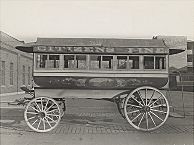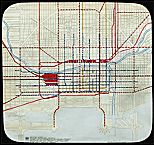| Entries |
| S |
|
Street Railways
|

|
Omnibuses, large carriages seating up to 30 people, first appeared in Chicago in 1852 to haul travelers between the new railroad stations and hotels. The first street railway, or horsecar line, opened in 1859. Horsecars, which typically seated 20 passengers on benches, were pulled by one or two horses along rails laid on the streets. They survived on lightly used lines until 1906.

|
The street railway systems in 1867 tried replacing horses with small steam locomotives called “dummies,” but the public objected to the smoke, noise, and sparks they generated. Chicago City Railways (CCRY) on the South Side in 1882 acquired cable car technology from San Francisco. The CCRY cable line on State Street proved so successful that Chicago's street railways eventually built more than 80 miles of lines—one of the largest such systems in the world.
Large steam engines mounted in central power plants pulled miles of cable through channels dug into the streets. The cable car operator, or gripman, applied power to the car by attaching his grip to the continuously moving cable.

|

|
Although the automobile did not become a factor in commuting in Chicago until the middle 1920s, the city's largest street railway, the Chicago Railways Company operating on the North and West Sides, filed for bankruptcy in 1926—a time at which ridership was at record levels and nearly three years before the onset of the Great Depression drove the remainder of the railways into bankruptcy. When it proved impossible to reorganize the street railways as a private enterprise, the state created the Chicago Transit Authority to buy them.
The last suburban streetcar ran on the West Town's system in 1948, and Chicago's last streetcar operated June 22, 1958, on the Clark-Wentworth line. The street railways were the victims of their own high costs, increased use of the automobile, overregulation, and population migrations to the suburbs. The street railways, which suffered declining profits after 1907 because of city and state regulation, did not have the money to build new lines into the suburbs.
The bankrupt CSL system, which included all five of the streetcar companies, was acquired by the new Chicago Transit Authority in 1947 for a bargain-basement price of $75 million. Its investors lost $110 million on the transaction.
The Encyclopedia of Chicago © 2004 The Newberry Library. All Rights Reserved. Portions are copyrighted by other institutions and individuals. Additional information on copyright and permissions.